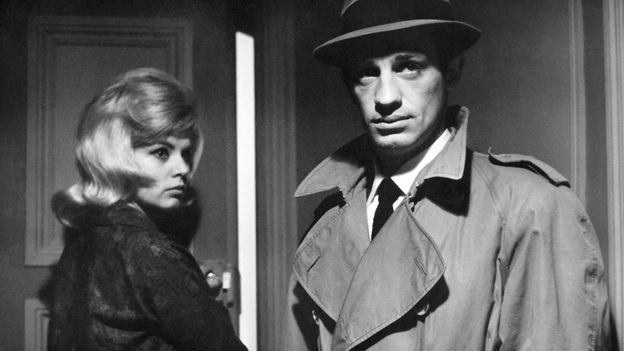
However, if Le Doulos followed in US film noir’s footsteps, there were also striking ways in which it diverged from its template – in part with its sheer intricacy. As Vincendeau puts it the “traditional clarity of action of the American cinema is challenged head-on by Le Doulos’s complex plotting, ambiguity and withholding of information, right from frame one”. Characters cannot trust each other, much to the misfortune of virtually everyone in the film. Whereas American noir would clearly reprimand its equally devious characters to highlight its moral core, Melville’s persistent ambiguity feels deeply Gallic.
Another difference between Le Doulosand the American cinema it referenced was its explicit portrayal of violence. In one infamous scene, Silien visciously beats Maurice’s girlfriend (Monique Hennessy), ties her by the neck to a radiator and throws whiskey in her face before interrogating her. The blunt, uncompromising brutality is exactly the sort that would find wider purchase in later crime films, in America and in Europe. In 1962, however, it was a bolt from the blue.
Just as Le Doulos was inspired by the US crime cinema that preceded it, the film’s distinctly visceral, hyper-tense style had an equal influence on future US crime films in return. Indeed, Melville’s heady combination of moody tropes from classic US noir and the rawer French style, which mixed equally chic with hints of documentary vividness, still holds a huge sway with American directors.
Martin Scorsese, for example, has cited Le Doulos as an influence. In preparation for filming The Irishman (2019), Scorsese screened it to his own director of photography Rodrigo Prieto. “For the tone of the movie, I wanted it to be contemplative and it had to be an intimate epic,” he told fellow director Spike Lee in an on-stage discussion around its release. “So I showed a couple of Jean-Pierre Melville films. I showed Le Doulos and Le deuxième soufflé. It’s a very different world, but I like the understatement of it.”
Tarantino is another high-profile admirer. When asked by interviewer Josh Becker about the inspirations for his 1992 debut film Reservoir Dogs, he replied: “It’s like the films of Jean-Pierre Melville, Bob le flambeur, Le Doulos, which is my favourite screenplay of all time, with Jean-Paul Belmondo; it’s fantastic.” Reservoir Dogs certainly borrowed Le Doulos’s style, but more specifically its finale is an echo of Melville’s, with a trio of men shooting each other dead, and all over a betrayal.
Le Doulos still stands today as one of the great crime films of the post-war years. In hindsight, it feels like a pivot point on which the crime films before and after turn, marking the genre’s transition from the melodramatic to coolly brutal. Pessimism on screen has never looked so good since; the city forever a lonely, rain-soaked place where death is waiting to collect and betrayal is always just around the corner.